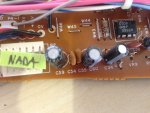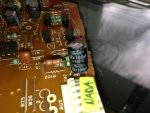Marigoldkh
New member
I'm up for the challenge, who knows I might even learn what to make of all those numbers and figures ha. I really appreciate the help.

The Cs and the Rs etc are called reference designators. You see them on the schematic and you will find them marked that way on the circuit boards. This is so when you are troubleshooting looking at the schematics and you want to probe around a certain cap you look on the schematic for its reference designator (say C37), then you find the same reference designator (C37) on the circuit board and go about your business. Even if all the caps on a circuit board were the same value, this is how you link where you are on the schematic with where they are on the board.
The polarized caps (electrolytics) will have markings. Most likely a black band on one side with "-" signs printed on the band. The circuit board will be marked with either a plus or a minus. Line up accordingly.
C14, C20, C25, C33, C34, C36, C48. If these are all the same, why didn't Tascam just use one type of cap...why label them different numbers? How did you know I need 7 of those caps for channels 3 & 4? Obviously all those add up to 7. I'm looking at pg 197-199. Can't seem to make sense of what I'm looking at. I now understand what the "C" and "R" stands for, but when I look at the schematic and then look at the circuit board, it doesn't look the same to me. It's like that scene in the Matrix where he is looking at the Matrix through the computer screen for the first time. I haven't located the women in the red dress yes:-/ Maybe I'll keep staring....

The Cs and the Rs etc are called reference designators. You see them on the schematic and you will find them marked that way on the circuit boards. This is so when you are troubleshooting looking at the schematics and you want to probe around a certain cap you look on the schematic for its reference designator (say C37), then you find the same reference designator (C37) on the circuit board and go about your business. Even if all the caps on a circuit board were the same value, this is how you link where you are on the schematic with where they are on the board.
The polarized caps (electrolytics) will have markings. Most likely a black band on one side with "-" signs printed on the band. The circuit board will be marked with either a plus or a minus. Line up accordingly.

If I were you, Marigoldkh, I would just leave opamps be. Get the board recapped and live with it for awhile. See if you are faced with sonic limitations and THEN explore the idea of those "upgrades" and ask serious questions about whether or not they will actually help you meet your needs. Putting a different chip in is NOT a silver bullet. Its not going to work miracles. There is so much more at play in the circuit design and circuit path and typically at BEST "improvements" are subtle, and at worst if not done right quality suffers.
Yup.
There's no reason to try and compare the schematic and the board as far as how parts are laid out. They are not going to be the same. The parts and how they relate to each other, yes, but the schematic is not drawn to represent the layout of the parts on the board. That's what the PCB layout is for on pages 138~140.
Thanks mdainsd! Ten four on the orientation. As for the schematics, would a guy like me even need to look at them. Seems to me if I have a parts list and if the circuit board has the corresponding numbers on them (C59) like this... View attachment 86796
OK cool, I've recorded and mixed on the 520 for a couple of years now and I can honestly say it does sound dark or brown. At first I didn't get why people were saying that...I do now. I'll take your advise though and let them be.

I knew you needed 7 of those 10uF/16V caps because I counted them up just like you did. Notice C36 is only installed on board types "b" and "c" (look at your list you put up several posts ago). Now look at the chart at the bottom of page 197. Notice C36 is only installed on board types "b" and "c" which are channels 3 and 4 respectively. The rest of the input boards in the M-512/520 only have 6 of those 10uF/16V caps. Make sense? That's why you need to tell me which channels you are planning on recapping because there are a number of caps only installed on boards "b" and "c", but not the others.
And your aggregate list of caps...recheck your count for the 22uF/25V. And what happened to the rest of the caps on the list?? Your list in post #465 has 26 caps, but your aggregate list in post #467 only has 18 caps...?
SO...
- Back to the drawing board somewhat on your aggregate list...
- STILL be thinking about the power supply
- TELL ME WHAT CHANNELS YOU ARE RECAPPING
Your turn.



